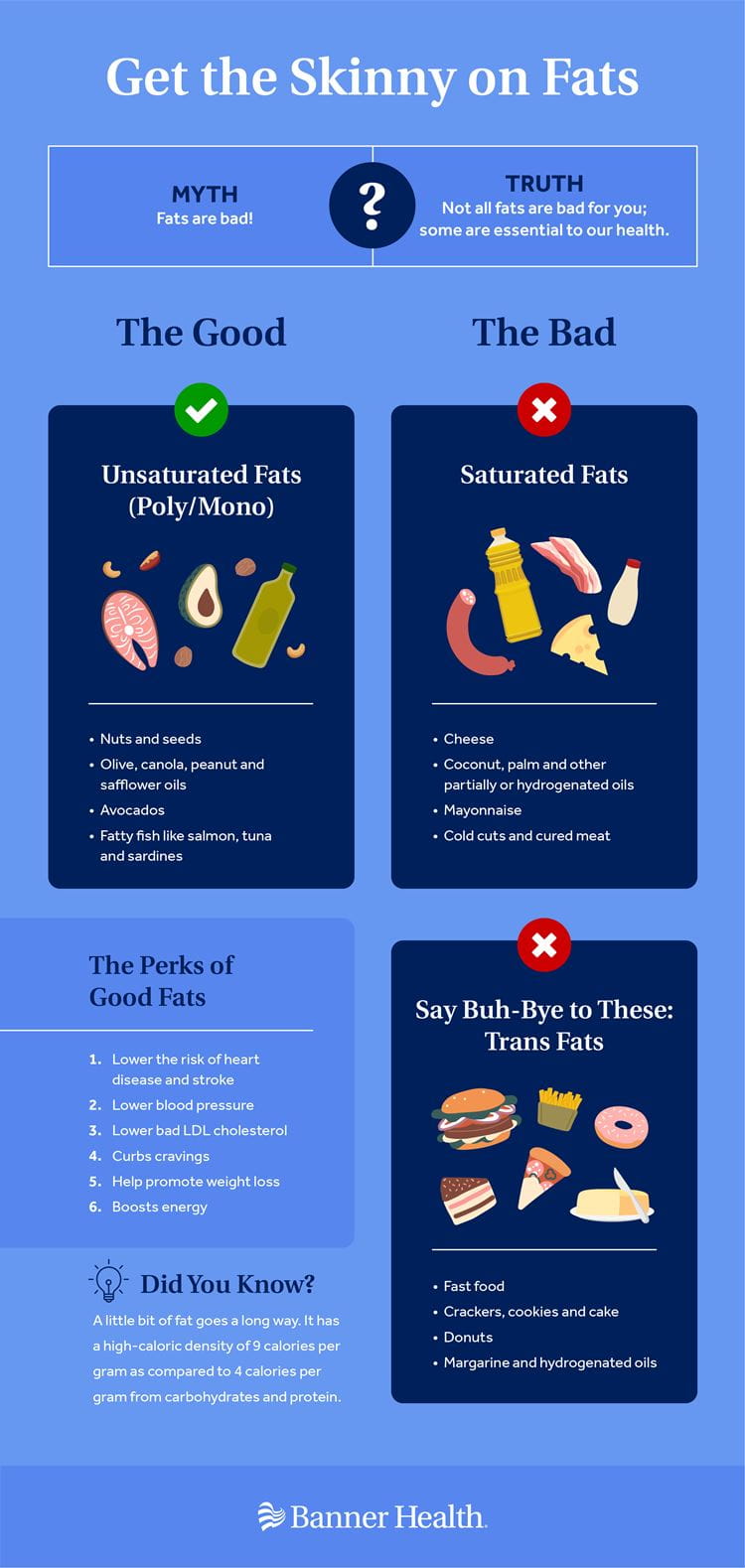What comes to mind when you hear the word “fat?”
Most of us are not a big fan of this three-letter word. There are many negative attitudes, emotions and opinions about the word fat. To some, it’s the other bad “F” word.
But fat isn’t as evil a word as you might think. Not all fats are bad fats—some are essential to good health.
To better understand the different types of fat (the good, the bad and the worst for you), we spoke with Nicole Hahn, a registered dietitian at Banner – University Medical Center Phoenix.
Good Fats: Unsaturated Fats (Mono/Poly)
Eaten in moderation, monounsaturated and polyunsaturated fats are the healthy kinds of fats to include in your diet. Why?
“Studies show diets rich in healthy fats can help lower bad cholesterol levels in the body and help lower your risk of heart disease and stroke,” Hahn said. “Unsaturated fats come from plant sources as well as fatty fish and are typically liquid at room temperature.”
Sources of Monosaturated Fats and Polyunsaturated Fats
“Sources of these fats contain a spectrum of types of fats—some are more heavily monounsaturated with a little polyunsaturated mixed in and others are heavily polyunsaturated with a little monosaturated fat mixed in,” Hahn said.
Items to Add to Your Shopping List
- Avocados
- Nuts and seeds
- Olives
- Unhydrogenated plant-based oils (olive, canola, safflower or sunflower oils)
- Fatty fish (salmon, trout, tuna and sardines)
Bad Fats: Saturated Fats
The U.S. Department of Health and Human Services recommends limiting the amount of saturated “bad” fats from your diet.
“While saturated fats do serve a purpose in our bodies, we do not want to consume them in excess,” Hahn said. “Diets high in saturated and trans fats can be one of the risk factors that lead to heart disease.”
These bad fats come from animal sources—primarily meat and dairy products—but there are also plant-based foods, such as coconut and cocoa butter, that contain saturated fats. To limit your intake, it’s recommended that no more than 7% to 10% of your daily calories come from saturated fats.
Items to Add to Shopping List
- Choose lean meats
- Reduced fat dairy
- Fruits, vegetables and whole grains to limit your intake
Just No Good at All: Trans Fats
And last and definitely least, trans fats.
Known as the worst type of fat, trans fats, also called trans fatty acids and partially hydrogenated oils, can be found in many of the foods we hate to love. They can be found naturally in some animal products, such as meat and whole milk, or in some baked goods.
Like saturated fats, trans fats can increase your bad cholesterol levels—but even worse, they can lower your good cholesterol too! This increases your risk for developing heart disease, stroke and is also associated with higher risk of developing type 2 diabetes. With such a negative impact on our health, the U.S. Food and Drug Administration (FDA) has taken steps to remove it.
“Since trans fats can have a negative impact on cholesterol levels, the FDA has mandated the removal of artificial trans fats from processed foods,” Hahn said.
Tips for Avoiding Trans Fat Foods
- Opt for naturally occurring unhydrogenated vegetable oils such as canola, safflower, sunflower or olive oil.
- Look for processed foods made with unhydrogenated oil rather than saturated fat or hydrogenated (or partially hydrogenated) vegetable oils.
- Limit fast food, fried food and baked goods made with shortening or partially hydrogenated vegetable oils.
- Products may have “hidden” trans fats, so read labels carefully.
“Don’t assume zero grams of trans fats listed on the label means there are no trans fats in the product,” Hahn said. “If there is up to 0.5 grams in the product, the label may say 0 grams. Read the list of ingredients and look for the words hydrogenated or partially hydrogenated in relation the oils in the products.
What tips do you have for eating healthier fats?
Hahn shared these added tips for including healthy fats into your diet:
- Add a tablespoon of chopped nuts to a salad
- Cook with a light drizzle of olive oil
- Incorporate more fish into your meals during the week
- Use avocados to make chicken or tuna salad instead of mayo
- Limit overly fatty meats, baked or other highly processed, high sugar and fried foods
Learn more about healthy eating and staying well, as well as healthy recipes at bannerhealth.com.



